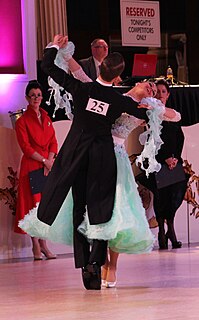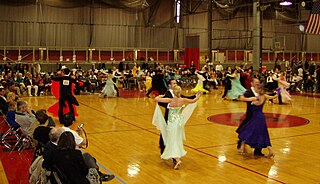
Ballroom dance is a set of partner dances, which are enjoyed both socially and competitively around the world, mostly because of its performance and entertainment aspects. Ballroom dancing is also widely enjoyed on stage, film, and television.
The Cecchetti method is variously defined as a style of ballet and as a ballet training method devised by the Italian ballet master Enrico Cecchetti (1850–1928). The training method seeks to develop essential skills in dancers as well as strength and elasticity. Cecchetti-trained dancers are commonly found in ballet and other dance companies throughout the world.
The World DanceSport Federation (WDSF), formerly the International DanceSport Federation (IDSF), is the international governing body of DanceSport and Wheelchair DanceSport, as recognised by the International Olympic Committee (IOC) and the International Paralympic Committee (IPC).

Dancesport is competitive ballroom dancing, as contrasted to social or exhibition dancing. In the case of wheelchair dancesport, at least one of the dancers is in a wheelchair.
This is an alphabetical index of articles related to dance.
Formation dance is a style of ballroom dancing. It is pattern or shadow team dancing by couples in a formation team. The choreography may be based on a particular dance or a medley of dances. Formation dancing may be done for exhibition or for competition between teams. There is also a type of formation in Bhangra.

The Imperial Society of Teachers of Dancing (ISTD) is an international dance teaching and examination board based in London, England. The registered educational charity, which was established on 25 July 1904 as the Imperial Society of Dance Teachers, provides training and examinations in a range of dance styles and certified dance teacher courses. The ISTD is recognised by the Qualifications and Curriculum Authority and the Council for Dance Education and Training and is also a member of the British Dance Council. It hosts various competitions in many different formats including Modern Ballroom, Latin American, Classical Ballet and Tap Dance as well as contemporary styles like Disco Freestyle.

The International Dance Teachers Association (IDTA) is a dance teaching and examination board based in Brighton, England. Operating internationally, the IDTA currently has over 7,000 members in 55 countries. The IDTA is recognised by the national qualifications regulators in England and Wales, Ofqual and the Council for Dance Education and Training, and is also affiliated to the British Dance Council, the Central Council of Physical Recreation and the Theatre Dance Council International. The IDTA works in partnership with the Royal Academy of Dance. The IDTA publishes a print and online magazine for members titled Dance International four times a year.
This page lists the official World Champions – Professional Ballroom of the World Dance Council (WDC), and its historical predecessors. The championships are authorized and organized under the auspices of the WDC. The designation Ballroom replaces the previously used Modern or Standard in WDC terminology; it does not include the latin dances.
Paul Killick is a British professional ballroom dancer and an International Latin American Dance Champion. He appeared in the first two series of the television show Strictly Come Dancing. Killick specialises in Latin dance and has won international titles including The World Cup, World Trophy, World Masters, World Series, Universal and British Professional Latin American DanceSport Championships.

Bangarra Dance Theatre is an Indigenous Australian contemporary dance company founded in 1989. Stephen Page was artistic director from 1991 to 2021, with Frances Rings taking over in 2022.
Ceremonial dancing has a very important place in the Indigenous cultures of Australia. They vary from place to place, but most ceremonies combine dance, song, rituals and often elaborate body decorations and costumes. The different body paintings indicate the type of ceremony being performed. They play an important role in marriage ceremonies, in the education of Indigenous children, as well as story telling and oral history. The term corroboree is commonly used to refer to Australian Aboriginal dances, although this term has its origins among the people of the Sydney region. In some places, Aboriginal people perform corroborees for tourists. In the latter part of the 20th century the influence of Indigenous Australian dance traditions has been seen with the development of concert dance, with the Aboriginal Centre for the Performing Arts (ACPA) providing training in contemporary dance.
The Arts in Australia refers to the visual arts, literature, performing arts and music in the area of, on the subject of, or by the people of the Commonwealth of Australia and its preceding Indigenous and colonial societies. Indigenous Australian art, music and story telling attaches to a 40–60,000-year heritage and continues to affect the broader arts and culture of Australia. During its early western history, Australia was a collection of British colonies, therefore, its literary, visual and theatrical traditions began with strong links to the broader traditions of English and Irish literature, British art and English and Celtic music. However, the works of Australian artists – including Indigenous as well as Anglo-Celtic and multicultural migrant Australians – has, since 1788, introduced the character of a new continent to the global arts scene – exploring such themes as Aboriginality, Australian landscape, migrant and national identity, distance from other Western nations and proximity to Asia, the complexities of urban living and the "beauty and the terror" of life in the Australian bush.
Performing arts education in Australia refers to the teaching of different styles of creative activity that are performed publicly. The performing arts in Australia encompasses many disciplines including music, dance, theatre, musical theatre, circus arts and more. Performing arts education in Australia occurs both formally and informally at all levels of education, including in schools, tertiary institutions and other specialist institutions. There is also a growing body of evidence, from the Australian Council for the Arts and the Parliament of Australia, showing that First Nation's participation in the arts and culture has significant economic, social and cultural benefits to Australia and further supports the outcomes of the Australian governments ‘Closing the Gap’ campaign. There has been an increasing number of scholarships opening up in educational institutions for Indigenous Australians aimed at encouraging this participation in the arts.
The British Dance Council was formed in 1929 as the Official Board of Ballroom Dancing (OBBD). The name was changed in 1985 to the British Council of Ballroom Dancing and in 1996, the name was changed to British Dance Council. The BDC is the recognised governing body for Ballroom, Latin American, Sequence & Freestyle Disco dance in the United Kingdom.
The annual United States Dance Championships (USDC), previously called the United States Ballroom Championships (USBC) and the United States DanceSport Championships (USDSC), is recognized by the National Dance Council of America (NDCA) and the World Dance & DanceSport Council (WD&DSC) as determining the majority of the United States national professional ballroom dance champions.

The English Amateur Dancesport Association (EADA) Ltd is a volunteer-led organisation which represents the interests of Amateur Dancers within England. EADA provides support and training for Amateur dancers and acts as the voice of English Amateur dancers amongst other dance organisations both in the UK and overseas. EADA also aims to get the younger audience involved and on the dance floor. EADA hopes to increase the profile of dancesport.
The Council for Dance, Drama and Musical Theatre (CDMT), formerly known as the Council for Dance Education and Training (CDET), is the quality assurance and membership body for the professional dance, drama and musical theatre industries in the United Kingdom. CDMT was founded in 1979.
The National Association of Teachers of Dancing promotes dance, and provides services to its members.